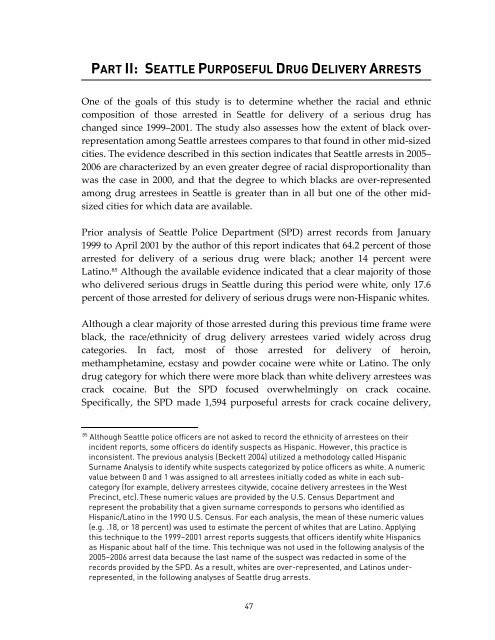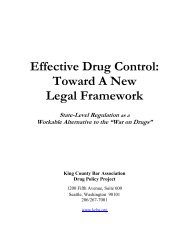RACE AND THE ENFORCEMENT OF DRUG DELIVERY LAWS IN ...
RACE AND THE ENFORCEMENT OF DRUG DELIVERY LAWS IN ...
RACE AND THE ENFORCEMENT OF DRUG DELIVERY LAWS IN ...
Create successful ePaper yourself
Turn your PDF publications into a flip-book with our unique Google optimized e-Paper software.
PART II: SEATTLE PURPOSEFUL <strong>DRUG</strong> <strong>DELIVERY</strong> ARRESTS<br />
One of the goals of this study is to determine whether the racial and ethnic<br />
composition of those arrested in Seattle for delivery of a serious drug has<br />
changed since 1999–2001. The study also assesses how the extent of black overrepresentation<br />
among Seattle arrestees compares to that found in other mid-sized<br />
cities. The evidence described in this section indicates that Seattle arrests in 2005–<br />
2006 are characterized by an even greater degree of racial disproportionality than<br />
was the case in 2000, and that the degree to which blacks are over-represented<br />
among drug arrestees in Seattle is greater than in all but one of the other midsized<br />
cities for which data are available.<br />
Prior analysis of Seattle Police Department (SPD) arrest records from January<br />
1999 to April 2001 by the author of this report indicates that 64.2 percent of those<br />
arrested for delivery of a serious drug were black; another 14 percent were<br />
Latino. 85 Although the available evidence indicated that a clear majority of those<br />
who delivered serious drugs in Seattle during this period were white, only 17.6<br />
percent of those arrested for delivery of serious drugs were non-Hispanic whites.<br />
Although a clear majority of those arrested during this previous time frame were<br />
black, the race/ethnicity of drug delivery arrestees varied widely across drug<br />
categories. In fact, most of those arrested for delivery of heroin,<br />
methamphetamine, ecstasy and powder cocaine were white or Latino. The only<br />
drug category for which there were more black than white delivery arrestees was<br />
crack cocaine. But the SPD focused overwhelmingly on crack cocaine.<br />
Specifically, the SPD made 1,594 purposeful arrests for crack cocaine delivery,<br />
85<br />
Although Seattle police officers are not asked to record the ethnicity of arrestees on their<br />
incident reports, some officers do identify suspects as Hispanic. However, this practice is<br />
inconsistent. The previous analysis (Beckett 2004) utilized a methodology called Hispanic<br />
Surname Analysis to identify white suspects categorized by police officers as white. A numeric<br />
value between 0 and 1 was assigned to all arrestees initially coded as white in each subcategory<br />
(for example, delivery arrestees citywide, cocaine delivery arrestees in the West<br />
Precinct, etc). These numeric values are provided by the U.S. Census Department and<br />
represent the probability that a given surname corresponds to persons who identified as<br />
Hispanic/Latino in the 1990 U.S. Census. For each analysis, the mean of these numeric values<br />
(e.g. .18, or 18 percent) was used to estimate the percent of whites that are Latino. Applying<br />
this technique to the 1999–2001 arrest reports suggests that officers identify white Hispanics<br />
as Hispanic about half of the time. This technique was not used in the following analysis of the<br />
2005–2006 arrest data because the last name of the suspect was redacted in some of the<br />
records provided by the SPD. As a result, whites are over-represented, and Latinos underrepresented,<br />
in the following analyses of Seattle drug arrests.<br />
47

















